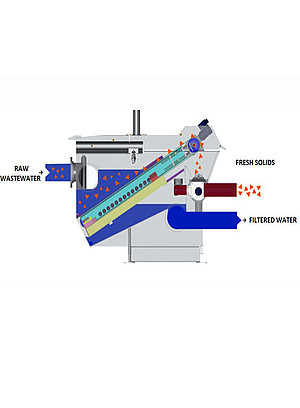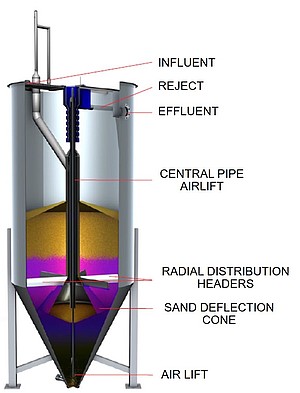The innovation of this project lies in early removal of solids and particulate BOD5 from raw sewage, using a special type of filter (microscreens/continuous backwash upflow media filter), prior to their entry into the aeration tank. In this way, the total electricity consumption will be reduced by 30-35%. Upon completion of the project, each WWTP will be able to process increased input loads and produce reclaimed water suitable for irrigation applications. The produced biosolids (sewage sludge) with solids content up to at least 30% are ideal for the production of fertilizer or energy utilization. At the same time, the project will upgrade the environment, both due to the qualitative upgrade of the processed effluents, and due to the reclaimed water reuse.
Microsieving
In the first step of the proposed system's wastewater treatment, a microsieve or a microscreen is used, removing 40-60% of the TSS (depending on the wastewater characteristics and the type of microsieve) while at the same time 30-50% of the BOD5 is removed. In general, Primary Sieved Solids (PSS) have better characteristics in comparison with primary biosolids, not only because a greater percentage of solids have been removed, but mainly because the larger solids (which are more difficult to be processed in the aeration tank) have been removed. The space required for the installation of a microsieve is at least 20 times smaller compared to primary sedimentation tanks. It should be noted that BOD5 is removed concurrently with the removal of solids, and specifically particulate BOD5, which is much more difficult and expensive to be removed biologically in correlation with soluble BOD5.
Continuous Backwash Upflow Media Filter (CBUMF)
It is a sand filtration system with a self-cleaning system of the sand bed. The proposed method (microsieve followed by the filtration system) results in the removal (downstream of the aeration tank) of up to 90% of the solids, while reducing BOD5 and COD by 60-70%.
The main advantages of CBUMF against conventional backwashing sand filters are the followings:
• Compact installation.
• Uninterrupted operation and processing.
• Continuous production of rejected water.
• Continuous backwashing.
• Absence of backwashing pumps.
• Low energy consumption.
• Small mounting area.


